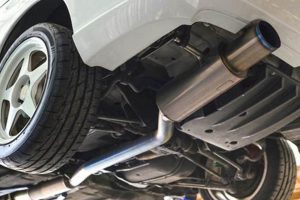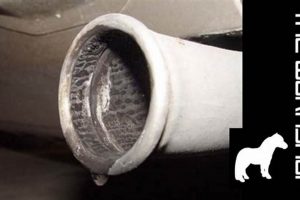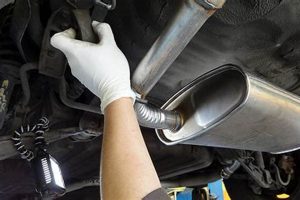The cost associated with replacing an exhaust silencing component in a vehicle can vary significantly. This expense is influenced by several factors, including the make and model of the automobile, the specific type of replacement component selected, and the labor costs incurred during installation.
A functional exhaust system, and particularly its silencing component, is critical for maintaining legal compliance with noise regulations, ensuring optimal engine performance, and contributing to a comfortable driving experience. Historically, these components were primarily focused on noise reduction, but modern designs often incorporate elements aimed at improving fuel efficiency and reducing emissions.
The following sections will detail the elements contributing to pricing variations, explore different types of components available, and provide a guide to estimating the overall financial outlay for this essential automotive repair.
Guidance on Muffler Replacement Costs
Considering the financial implications of replacing an automotive exhaust silencing component requires a multifaceted approach. Careful planning and informed decision-making can mitigate unexpected expenses.
Tip 1: Obtain Multiple Quotes: Contact several reputable automotive repair facilities for cost estimates. This allows for comparison shopping and identification of potential discrepancies in pricing.
Tip 2: Specify Muffler Type: Differentiate between aftermarket and Original Equipment Manufacturer (OEM) components. OEM parts are typically more expensive but offer guaranteed compatibility. Aftermarket options may be more economical but require careful verification of suitability.
Tip 3: Inquire About Labor Charges: Understand the hourly rate and estimated labor time for installation. Some facilities offer flat-rate pricing, while others bill based on actual time spent.
Tip 4: Inspect the Entire Exhaust System: A faulty silencing component may indicate underlying issues within the exhaust system. Address any corrosion or damage to pipes or catalytic converters concurrently to prevent future repairs.
Tip 5: Consider Material Quality: Exhaust components are available in various materials, including aluminized steel, stainless steel, and titanium. Stainless steel and titanium offer greater corrosion resistance and longevity, potentially justifying a higher initial investment.
Tip 6: Verify Warranty Coverage: Inquire about the warranty offered on both the replacement component and the installation labor. A comprehensive warranty provides protection against premature failure.
Tip 7: Check for Local Regulations: Some jurisdictions have specific requirements for exhaust system modifications or noise levels. Ensure the replacement component complies with all applicable regulations.
By implementing these strategies, individuals can gain a clearer understanding of the expenses associated with exhaust silencing component replacement and make informed choices that align with their budgetary constraints and vehicle maintenance needs.
The subsequent sections will provide a more in-depth analysis of muffler types and their respective cost profiles.
1. Vehicle Make/Model
The vehicle’s make and model significantly influence the expense associated with replacing an exhaust silencing component. This relationship stems from variations in component design, materials utilized, and the complexity of the exhaust system architecture across different vehicles. For instance, a replacement for a common sedan, such as a Honda Civic or Toyota Corolla, typically incurs lower costs due to mass production and readily available aftermarket options. Conversely, vehicles with specialized exhaust systems, such as high-performance sports cars (e.g., Porsche 911) or luxury SUVs (e.g., Range Rover), often necessitate unique or proprietary components, thereby increasing the price.
Furthermore, the complexity of the exhaust system and its integration with other vehicle systems can impact labor costs. Some vehicles require extensive disassembly to access and replace the silencing component, resulting in higher labor charges. Consider a situation where a faulty component on a classic car requires fabrication due to a lack of available parts. In such cases, expenses escalate due to the specialized labor and materials involved. The model’s age also plays a role. Parts for older models can be difficult to find, thereby driving up prices for either OEM or custom-fabricated components.
In summary, the vehicle’s make and model represent a foundational determinant of the total expenditure. Understanding this connection enables owners to anticipate potential costs and explore options appropriate to their specific vehicle’s requirements. The correlation is direct: more unique and complex system designs yield more expensive replacements, affecting component costs and labor time.
2. Muffler Type
The type of exhaust silencing component directly influences its cost. Several distinct types are available, each characterized by unique construction, performance characteristics, and price points. Chambered components, for instance, utilize a series of internal chambers to attenuate sound waves. These are generally less expensive than performance components, like straight-through designs that prioritize exhaust flow over maximum noise reduction. Turbo components, designed for turbocharged vehicles, may require specific materials and construction to withstand higher exhaust pressures, adding to the cost. Furthermore, factory-style components are often less expensive than those marketed for performance applications.
The choice of component also has ramifications beyond the initial purchase price. A low-cost, generic component may offer limited durability, leading to more frequent replacements and increased long-term expenses. Conversely, a high-quality component made of stainless steel offers greater longevity and resistance to corrosion, justifying the higher initial investment. For example, installing a generic replacement on a vehicle driven in a region with heavy road salting will likely necessitate an earlier replacement compared to a higher-quality, corrosion-resistant option. The selection of component type, therefore, constitutes a critical decision point that directly impacts the overall cost of vehicle maintenance.
In summary, variations in silencing component type contribute significantly to pricing differences. Chambered designs are generally more economical, while specialized, high-performance, or application-specific components command a premium. Consideration of long-term cost implications, including component durability and maintenance requirements, is essential when making a selection. The type chosen should align not only with budgetary constraints but also with the vehicle’s intended use and the prevailing environmental conditions to ensure optimal value.
3. Material Quality
Material quality is a primary determinant of the price associated with an exhaust silencing component. The materials employed directly impact the component’s durability, resistance to corrosion, and overall lifespan, thereby influencing its market value. For example, components constructed from aluminized steel are generally less expensive due to their lower material cost. However, aluminized steel offers limited resistance to corrosion, particularly in environments with high humidity or road salt exposure, leading to a shorter lifespan and potentially earlier replacement. Conversely, stainless steel components command a higher price due to their superior corrosion resistance and extended lifespan. Premium materials like titanium, while offering exceptional durability and weight reduction, further escalate the cost due to their rarity and specialized manufacturing processes. The correlation is direct: enhanced material properties correspond to increased component cost, reflecting a trade-off between initial expenditure and long-term durability.
The practical significance of understanding the material quality-price relationship is considerable. For instance, a vehicle owner residing in a coastal region may opt for a stainless steel component despite its higher initial cost, recognizing that its enhanced corrosion resistance will prevent premature failure and the associated replacement expenses. Conversely, an owner in a dry climate with minimal road salt exposure may find that an aluminized steel component provides adequate performance at a lower cost. Furthermore, understanding the material composition enables informed decisions regarding maintenance practices. For instance, applying protective coatings to aluminized steel can extend its lifespan, mitigating corrosion and delaying the need for replacement. A similar connection can be seen in performance exhausts with titanium components where the lightweight material has performance advantage in race applications. In this instance, a higher premium may be justified due to weight saving and overall product lifespan in high-stress environments.
In summary, material quality represents a critical factor in determining component pricing. The choice of material should reflect a balance between budgetary considerations and the vehicle’s operating environment. Recognizing the impact of material properties on durability and longevity empowers vehicle owners to make informed decisions that optimize value and minimize long-term maintenance expenses. The initial price difference between materials often reflects a corresponding difference in expected lifespan and performance, highlighting the importance of considering the total cost of ownership rather than solely focusing on the initial purchase price.
4. Labor Costs
Labor costs represent a significant component in the overall expense associated with replacing an exhaust silencing component. These costs are influenced by various factors, including the complexity of the installation process, prevailing hourly rates at repair facilities, and regional variations in labor markets. Understanding these elements is crucial for accurately estimating the financial implications of this automotive repair.
- Vehicle Accessibility
The accessibility of the exhaust system on a specific vehicle directly impacts labor time. Some vehicles feature easily accessible exhaust systems, allowing for swift removal and replacement. Others require extensive disassembly of surrounding components, such as heat shields, suspension components, or underbody panels, significantly increasing the time required for the job. For example, replacing a component on a rear-wheel-drive truck is generally less labor-intensive than on a transversely mounted, front-wheel-drive car where surrounding engine components may obstruct access.
- Component Complexity
The design and integration of the exhaust silencing component within the exhaust system also influence labor time. Systems with welded components or seized fasteners may necessitate specialized tools and techniques, thereby prolonging the installation process. For example, a vehicle with a rusted or corroded exhaust system may require cutting and welding, adding to the labor cost. Similarly, complex exhaust systems with multiple components and sensors often require more time for disassembly and reassembly.
- Hourly Labor Rates
Prevailing hourly labor rates at automotive repair facilities vary significantly based on geographic location, the facility’s reputation, and the technician’s skill level. Repair shops in urban areas or those specializing in high-performance vehicles typically charge higher hourly rates compared to rural or general repair facilities. A shop with certified technicians and specialized equipment may also command higher rates. Obtaining quotes from multiple shops is essential to compare labor rates and identify potential cost savings. Furthermore, some shops offer flat-rate pricing for specific jobs, while others bill based on actual labor time. Understanding the shop’s billing practices is crucial for accurately estimating labor costs.
- Additional Services
In some cases, replacing an exhaust silencing component may necessitate additional services, such as welding, pipe bending, or sensor replacement. These additional services can significantly increase labor costs. For example, a severely corroded exhaust system may require welding to repair damaged pipes or flanges. A faulty oxygen sensor discovered during the replacement process may also require immediate attention, adding to the overall expense. Clear communication with the repair facility is essential to identify potential additional services and obtain accurate cost estimates.
In summary, labor costs represent a substantial portion of the overall expense. Factors such as vehicle accessibility, component complexity, prevailing hourly rates, and the need for additional services influence these costs. The degree to which these factors are understood will translate into the accuracy of cost-estimating for exhaust silencing component replacement.
5. Geographic Location
Geographic location directly influences the cost of an exhaust silencing component replacement. This influence manifests through several interconnected factors, primarily affecting both parts and labor pricing. For instance, regions with higher costs of living, such as major metropolitan areas, typically exhibit elevated labor rates at automotive repair facilities. Simultaneously, material costs may be higher due to increased transportation expenses and local market demand. Conversely, rural areas or regions with lower overall costs of living may offer more competitive pricing on both parts and labor. A vehicle owner replacing a component in Manhattan will likely encounter higher expenses than one in rural Kansas, even for the same vehicle make and model.
Furthermore, environmental conditions specific to certain geographic locations impact the lifespan of exhaust components, indirectly influencing replacement frequency and associated costs. Coastal regions with high humidity and salt air exposure accelerate corrosion, necessitating more frequent replacements and increasing the overall cost of vehicle maintenance. Similarly, areas with harsh winters and heavy road salt usage subject exhaust systems to accelerated deterioration. In these regions, investing in higher-quality, corrosion-resistant components, such as stainless steel, becomes a more economically sound decision, despite the higher initial purchase price. Parts distribution networks can also affect costs; areas farther from major distribution hubs may experience higher shipping fees incorporated into the final price.
In summary, geographic location serves as a critical determinant of component replacement costs. This influence stems from variations in labor rates, material pricing, environmental conditions, and distribution networks. A comprehensive understanding of these geographic factors enables vehicle owners to make informed decisions tailored to their specific location, optimizing value and minimizing long-term maintenance expenses. The prevailing costs, environmental aggressors, and part availability are all location-dependent variables affecting the expenditure.
6. Warranty Terms
The warranty terms associated with exhaust silencing components exert a considerable influence on the total cost of ownership, directly impacting potential expenses related to replacement or repair. A comprehensive understanding of these terms is essential for informed decision-making during the purchasing process.
- Coverage Duration
The duration of the warranty period is a primary consideration. A longer warranty period provides extended protection against premature component failure, mitigating potential expenses should the component malfunction or degrade within the specified timeframe. For example, a component with a lifetime warranty theoretically eliminates replacement costs due to defects in materials or workmanship. However, lifetime warranties often have limitations regarding transferability or specific failure conditions.
- Scope of Coverage
The scope of coverage defines the specific types of failures or defects that are covered under the warranty. Some warranties may cover only defects in materials or workmanship, excluding failures resulting from corrosion, physical damage, or improper installation. A comprehensive warranty would ideally cover a broader range of potential failures, providing greater financial protection. For instance, a warranty that excludes corrosion damage would be of limited value in regions with high road salt usage.
- Labor Reimbursement
The reimbursement for labor costs associated with warranty repairs or replacements varies significantly. Some warranties cover the cost of labor entirely, while others offer partial reimbursement or exclude labor costs altogether. Labor costs can represent a substantial portion of the total replacement expense, particularly for complex exhaust systems. A warranty that fully covers labor costs provides significant financial relief in the event of a covered failure.
- Exclusions and Limitations
Warranty terms typically include various exclusions and limitations that restrict the coverage provided. Common exclusions include damage resulting from misuse, accidents, modifications, or racing applications. Furthermore, warranties may be voided if the component is installed improperly or by an unauthorized repair facility. Understanding these exclusions and limitations is critical to ensuring that the warranty remains valid and provides the intended financial protection. For example, installing an aftermarket component without proper certification might void the warranty on related exhaust system components.
In conclusion, warranty terms play a crucial role in determining the overall cost of ownership. Longer coverage durations, comprehensive scopes of coverage, full labor reimbursement, and clearly defined exclusions and limitations contribute to a more valuable warranty. Evaluating these aspects carefully allows vehicle owners to make informed purchasing decisions that minimize potential expenses and maximize long-term value. A higher initial component price accompanied by a superior warranty might represent a more economically sound choice than a cheaper component with limited or restrictive warranty coverage.
Frequently Asked Questions
The following section addresses common inquiries regarding the costs associated with replacing an automotive exhaust silencing component. These questions aim to provide clarity and facilitate informed decision-making.
Question 1: What factors primarily determine the price of a replacement silencing component?
The price is influenced by the vehicle’s make and model, the component type (e.g., chambered, performance), the material quality (e.g., aluminized steel, stainless steel), labor costs for installation, geographic location affecting pricing, and the warranty terms offered.
Question 2: Is it possible to reduce the expense of silencing component replacement?
Cost reductions can be achieved by obtaining multiple quotes from reputable repair facilities, specifying the desired component type, inquiring about labor charges, inspecting the entire exhaust system for related issues, considering material quality for longevity, and verifying warranty coverage details.
Question 3: How does the choice of material impact the long-term cost?
Higher-quality materials, such as stainless steel, offer increased corrosion resistance and extended lifespan, potentially reducing long-term expenses despite a higher initial investment compared to less durable materials like aluminized steel. Premature failure would result in more expenses for low-quality components.
Question 4: Why do labor costs vary between repair facilities?
Labor costs fluctuate based on the complexity of the installation, the accessibility of the exhaust system on the vehicle, prevailing hourly rates at the facility, the technician’s skill level, and the geographic location, with urban areas typically exhibiting higher rates.
Question 5: How does geographic location influence the overall replacement cost?
Geographic location affects labor rates, material pricing, environmental conditions (e.g., coastal regions accelerating corrosion), and parts distribution networks, all contributing to variations in overall replacement costs.
Question 6: What should be considered when evaluating the warranty terms?
Important considerations include the coverage duration, scope of coverage (e.g., defects in materials or workmanship), labor reimbursement policies, and any exclusions or limitations that could restrict the warranty’s applicability.
Understanding these factors and considering the presented strategies will enable individuals to make informed decisions regarding exhaust silencing component replacement, optimizing value and minimizing potential expenses.
The subsequent sections provide a comprehensive guide to selecting a suitable repair facility and ensuring a successful replacement process.
Determining Exhaust Silencing Component Replacement Expenditure
The comprehensive analysis presented illustrates that estimating the expenditure for silencing component replacement is a multifaceted undertaking. Primary cost drivers include vehicle specifications, component type and material, labor inputs, geographic location, and warranty provisions. Accurate cost prediction mandates a thorough evaluation of these interacting factors.
The diligent consideration of these variables facilitates informed decision-making and mitigates unforeseen financial burdens. Individuals should exercise due diligence in securing multiple estimates and scrutinizing warranty conditions to ensure optimal economic outcomes. The importance of a functioning, code-compliant exhaust system underscores the value of proactive maintenance and responsible repair practices.







